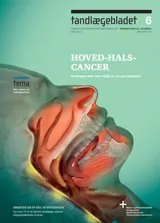Kræft i svælget – kan forårsages af virus og livsstil
Der diagnosticeres ca. 400 patienter med kræft i svælget om året i Danmark. Svælgkræft opdeles efter anatomisk lokalisation i kræft i henholdsvis næsesvælg, mundsvælg og strubesvælg med forskellig ætiologi, epidemiologi og behandling. Mundsvælgkræft er i epidemisk stigning over hele den vestlige verden grundet human papillomavirus 16 (HPV). I Danmark er forekomsten af mundsvælgkræft femdoblet i løbet af de sidste 30 år, og det vides endnu ikke, hvor stor en del som er forårsaget af HPV. HPVnegativ (HPV–) mundsvælgkræft er associeret til alkohol- og tobaksmisbrug, og den vigtigste prognostiske faktor er tilstedeværelsen af lymfeknudemetastaser på diagnosetidspunktet. Patienter, som har HPV-positiv (HPV+) mundsvælgkræft, adskiller sig fra HPV– patienter mht. epidemiologi, klinik, patologi og prognose. HPV+ patienter er typisk yngre mænd uden tobaks- og alkoholmisbrug med en fremskreden tonsil- eller tungebasiskræft pga. metastasering til halsens lymfeknuder. På trods af dette har patienterne en god prognose i forhold til HPV– mundsvælgkræftpatienter. Næsesvælgkræft optræder endemisk i det sydlige Kina, Nordafrika, Alaska samt i Grønland og er associeret til Epstein-Barr Virus (EBV). Strubesvælgkræft er forårsaget af tobaks- og alkoholmisbrug. Patienterne diagnosticeres ofte i sene stadier og har en dårlig prognose.
Cancer in pharynx – can be caused by viruses and life style
Approximately 400 patients are diagnosed with pharyngeal cancer every year in Denmark. Pharyngeal cancer is divided according to the anatomical location into cancer in the nasopharynx, oropharynx and hypopharynx with different etiology, epidemiology and treatment. The incidence of oropharyngeal cancer is rising epidemically all over the Western world due to human papillomavirus 16 (HPV). In Denmark the prevalence of oropharyngeal cancer has increased five-fold during the last 30 years and it is currently not known which proportion of these can be attributed to HPV. HPV negative (HPV–) oropharyngeal cancer is associated with tobacco and alcohol abuse, and the most important prognostic factor is the presentation of lymph node metastasis at the time of diagnosis. Patients with HPV positive (HPV+) oropharyngeal cancer constitute a distinct group regarding epidemiology, clinical characteristics, pathology and prognosis. An HPV+ oropharyngeal cancer patient is typically a younger man without a history of tobacco and alcohol abuse who presents with a metastatic tonsillar- or base of tongue cancer and despite this the patient has a better prognosis compared to an HPV-oropharyngeal cancer patient. Nasopharyngeal cancer is endemically present in Southern China, Northern Africa, Alaska and Greenland and is associated to Epstein-Barr Virus (EBV). Hypopharyngeal cancer is caused by alcohol and tobacco consumption. The patients are often diagnosed in advanced stages and have a bad prognosis.


